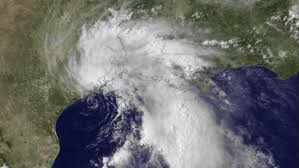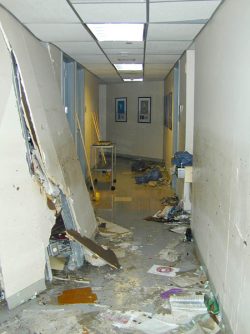Did You Know? Years of Research Were Lost During Tropical Storm Allison

Some call it The Great Flood of 2001. In the early hours of June 9 that year, Tropical Storm Allison unleashed torrential rains that brought the Texas Medical Center (TMC) to its knees. Nearby Brays Bayou quickly overtopped its banks and spilled into streets and TMC buildings, most of which are interconnected through an underground network of tunnels, parking garages, utility chases, and loading docks. As surface-level flooding mounted, these underground conduits ushered in floodwaters that completely submerged the basements of TMC hospitals and research facilities—basements that housed not only critical diagnostic equipment and electrical/HVAC infrastructure, but also more than half of the research animals belonging to Baylor College of Medicine, UTHealth, and THI.
Many animal care providers attempted to reach basement vivariums through waist-deep water and closed roadways, but they arrived too late. Others trying to salvage years of work barely escaped before the rapidly rising water broke through the laboratory doors. Within hours, Baylor College of Medicine had lost 90,000 research animals, 60,000 tumor samples, and 25 years of research data; UTHealth also lost thousands of laboratory animals. At THI, years of work on the artificial heart and heart-assist devices were wiped out. The entire Cullen Cardiovascular Surgical Research Laboratory was inundated and destroyed, and test animals were drowned.


By the time Allison drifted eastward toward New Orleans, the storm had dropped roughly 32 trillion gallons of water (80% of Houston’s total average annual rainfall); UTHealth alone pumped more than 10 million gallons of water from its basement. Damages in the TMC topped $6 billion (of which only $2.5 billion was insured). Nine of the 13 hospitals in the TMC were closed for some period of time. All of this was caused by a storm that at its most intense had sustained winds of only 57 mph.
Missing from these statistics are stories of human kindness, resilience, and creativity under pressure. Hospital staff, physicians, vendors, contractors, and the community responded with a common priority—to ensure the safety of hospitalized patients while evacuating as many as possible from the crippled facilities. With the power out, many patients had to be hand-ventilated, some for more than 12 hours while awaiting transport to unaffected hospitals in Houston, San Antonio, or Dallas. Hundreds of patients were evacuated from the roof or carried down darkened, sweltering stairwells on backboards and loaded onto Army Black Hawk helicopters. One patient could not be brought down the stairs, so volunteers broke a window, and the patient was lowered down by crane. St. Luke’s employees formed a human chain in the stairwell of the 23-story hospital, passing food and supplies to floors where needed. Countless volunteers supplied fresh energy and strength.

The TMC did have flood barriers and emergency action plans in place in 2001, but these were clearly inadequate to handle such rapid, catastrophic rainfall accumulation. Within 2 years of Allison, the TMC boosted its hazard-mitigation plans to provide protection at the 500-year flood level. All hospitals now have backup generators and above-ground power-distribution centers. More than 170 submarine-type flood doors were installed to protect vulnerable low-lying entryways and below-ground tunnels; these doors can be sealed with an inflatable bladder and can withstand water up to 12 feet deep. A fully-staffed operations center monitors the weather and water levels in Brays Bayou around the clock, and a radar-based flood warning system developed at Rice University runs real-time rainfall models for the TMC. These measures proved their worth when major Hurricane Ike struck Houston in 2008. The buildings withstood the high winds, and flooding and power outages were avoided.




